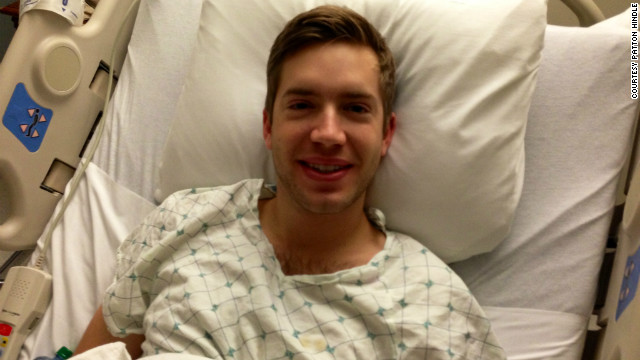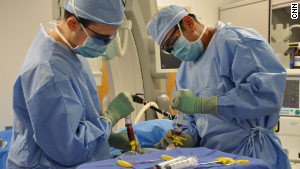
William Hudson, a producer in the CNN Medical Unit, donated his own bone marrow to an anonymous recipient.
STORY HIGHLIGHTS
- About 1 in 40 registry members will receive a potential donor letter at some point
- Timeline, from first contact to donation, depends on recipient's health and treatment schedule
- Minorities have lower chances of finding willing and able donors
I knew that no matter how
much time and money I did or did not donate to nonprofits and charities
doing important work, this was different. Here was a patient with a
blood cancer whose particular immune system resembled my own. Turns out
I, among potentially everyone in the world, was in the best position to
save her life.
It's an awesome responsibility and opportunity.
Now that I've been
through the entire experience, including the ominous-sounding procedure
called a "bone marrow harvest," it's clear that the most decisive point
for me was simply joining the registry in the first place.
Joining is a small time investment --
all it takes is a few cotton swabs of saliva -- but understandably
seems to have no pay off. The chances of ever becoming a donor are only
about 1 in 540.
But if a donor request
letter does come, as it did for me, the tangible opportunity to save
someone's life is so compelling and immediate that the next steps
seemingly take no effort at all.
Getting the letter
About 1 in 40 registry
members will receive a potential donor letter at some point, according
to the donor program. This just indicates that based on the saliva
sample, you might be the match for somebody.
I was on the registry for five years before I received a potential donor letter.
Here's what happened next.
I called Be the Match and told them I was still willing and able.
A specialist assigned to
this case scheduled my initial blood test. This allowed them to
determine whether I was really the best match for the intended
recipient.
Through the entire process you just call and e-mail with your assigned specialist, which makes things easy.
PBSC vs. Bone Marrow
If the match is a good
one, you next get to choose whether to donate actual bone marrow, or
what's called peripheral blood stem cells, known as PBSC. The patient's
doctor will request one or the other, but ultimately the donor decides
which one he or she feels willing to give.

On the whole, donating bone marrow is a very low-risk procedure, with 1.3% of donors experiencing complications.
I was curious how the decision would affect my recipient's chances of survival. That's what this is all about, after all.
"When we look at PBSC
versus bone marrow, we see comparable outcomes in adults," Dr. John
Miller, a medical director at Be the Match and the National Marrow Donor
Program, told me.
"When we look at
outcomes in children, we see better outcomes with bone marrow, and
long-term outcomes in terms of complications are lower with marrow than
with PBSC, so most pediatric transplants use marrow as the transplant
source."
Because my recipient is an adult, I felt comfortable with picking either of the two options.
A bone marrow harvest is
a minor surgical procedure usually done under general anesthesia, so
the donor remembers nothing and experiences no pain except in rare
cases. A needle is inserted into the back of the pelvic bone, and bone
marrow is drawn out with syringes.
"A small percentage
(1.3%) of donors experience a serious complication due to anesthesia or
damage to bone, nerve or muscle in their hip region," according to Be
the Match.
On the whole, it's a very low-risk procedure, and it's the one I chose.
However the more common
option is to donate peripheral blood stem cells. This requires one
injection each day for five days of a drug called filgrastim, which
moves stem cells out of the bone marrow, and into the blood stream.
During this process, the donor feels achy and sore.
On the fifth day, the
donor is connected to an apherisis machine, which draws blood from one
arm, isolates the stem cells now circulating in the blood, and then
transfuses the donor's blood right back into the other arm. This
typically takes four to six hours.
The drug filgrastim is
widely considered to be safe by clinicians, with the one caveat that
there's limited data specifically about the long-term effects of the
drug on healthy donors.
As a donor, that gave me pause. So I looked into what we do know.
In 2009, researchers found
that there's "no evidence of increased cancer risk," though study
participants had been followed for, on average, about four years.
Miller, who is also one
of the study authors, says the latest data continues to indicate no
increased risks from taking filgrastim for a PBSC donation.
Donating PBSC simultaneously enrolls you in an ongoing clinical trial to assess long-term risks and benefits.
Making the donation
Six months passed from
the day Be The Match first contacted me to the day of donating. The
timeline just depends on the recipient's health and treatment schedule.
Of course, there are
lots of consent forms to sign, and a complete physical exam with a chest
X-ray, EKG, and blood and urine samples before giving the green light
for the donation.
The collection itself
often requires traveling to another city, but everything from airfare
and taxis to hotels and meals is paid for or reimbursed, for you and a
companion.
My bone marrow harvest
took about an hour. Doctors kept me in the hospital overnight, but not
with regular hospital food. Ruth's Chris Steak House caters to marrow
donors at my assigned hospital.
The next day I walked
out, slowly and a bit sorely, with instructions to take it easy for two
weeks as my body replaces the lost marrow.
Immediately after a bone
marrow harvest, a volunteer courier travels -- by plane, train, or
automobile -- with the stem cells and personally delivers them directly
to the patient's location. At this point, the patient's abnormal bone
marrow cells have already been intentionally destroyed by chemotherapy
and/or radiation therapy, and the healthy stem cells are given to the
patient through an IV drip.
Once infused, the stem
cells automatically travel to the recipient's bone cavities and -- if
the transplant is successful -- begin making healthy blood cells.
My recipient could be almost anywhere in the world: 51% of transplants through Be The Match
involve an international donor or recipient. If we both consent, we can
meet after at least one year, but either of us could choose to remain
anonymous.
I hope to meet her.
I've created a fairly specific, though imaginary, image in my head of what she looks like, and the teary hug we would share.
Joining the registry is a statement: that when cancer affects one of us, it affects all of us.
All I know about my recipient is her age, diagnosis, and that she likely shares my English ancestry.
Minorities have lower
chances of finding willing and able donors, as minority groups are not
as well represented on the donor registry. For African-American
patients, there's an estimated 66% likelihood of finding a donor.
The entrepreneur Amit Gupta,
who was diagnosed in 2011 with Leukemia, was able to find a donor only
after waging an online campaign encouraging more South Asians in the
U.S. and abroad to join donor registries.
An average 54,000 people join Be The Match Registry every month.
To donate, go to marrow.org.
 4:21 PM
4:21 PM
 specialshowtoday
specialshowtoday

 Posted in:
Posted in: 

0 comments:
Post a Comment